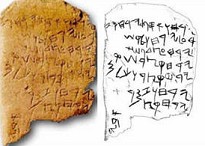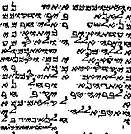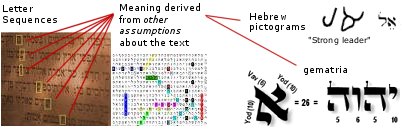|
| There seems to be a univeral idea amoung non Jewish people that "all that is Jewish is gold....or God....or somehow never to be questioned and always accepted. This made for many Messianic Cults and Christian Cults all using "Jewishness" as a "Covering" for false doctrine, false teaching, and even anti-christ like behaviour that I John warned about. In my experience with Numerous Orgs in and out of Messianic Circles while there is some good for those who are Jewish, I find most Christians just can't tell the forest from the Trees in Hebrew or Jewish studies. Whether it be the Trim ARAMAIC ONLY CULT, or the Texas based YAH YAH or YAHOO"ES or DEAD SEA SCROLLERS or QUMRAN CULTISTS, somehow people want more than thier bible says and find themselves in Gross Error. Jews4Jesus, Hebrew4Christians, Chosen People, are a very very few I feel confortable supporting and have fully investigated and found sound. Others, I have personal issues that I can be contacted on in email for concerns I may have about. Many are famous, most I met In Jerusalem at one time. If you are "caught up" in the latest "buzz" of a "new" revelation just found or a New "translation" made, YOU are wrong and need to discover new discoveries ONLY have validated not negate what we have today. Jews, who are biblical scholars, and scripturally accurate, can biring a joy to your studies. -Michael James Stone
| |
|
| ||||||||||||||||||||||||||||
|
 The earliest surviving Hebrew inscription is the Gezer Calendar (c. 10th century BC) which displays this ancient script. Ketav Ivri was used until the First Temple was destroyed by the Babylonians in 586 BC (though it was discovered in some later texts of the Dead Sea Scrolls, and the zealot Simon Bar Kochba also used it on coins for nationalistic purposes during the last of the Jewish-Roman wars in c.132-135). The earliest surviving Hebrew inscription is the Gezer Calendar (c. 10th century BC) which displays this ancient script. Ketav Ivri was used until the First Temple was destroyed by the Babylonians in 586 BC (though it was discovered in some later texts of the Dead Sea Scrolls, and the zealot Simon Bar Kochba also used it on coins for nationalistic purposes during the last of the Jewish-Roman wars in c.132-135). After Cyrus the Great overthrew the Babylonians and allowed the Jews to return to their promised homeland, Ezra the Scribe [עזרא הסופר] (c. 450 BC) and the members of the Great Assembly adopted the (Babylonian) Aramaic-style script for the Scriptures (called ketav Ashurit). Ezra and the Great Assembly also established the weekly Torah reading schedule and instituted the Amidah (standing) prayer (among other reforms). The reason for the script change probably had to do with distancing the returning Jewish people from the "imported" Samaritans who recently had adopted Judaism (and the Jewish Torah) as their new tribal religion. Ezra's transliteration makes it less surprising to understand why traditional Judaism maintains that his knowledge of the Torah was equal with that of Moses himself. After Cyrus the Great overthrew the Babylonians and allowed the Jews to return to their promised homeland, Ezra the Scribe [עזרא הסופר] (c. 450 BC) and the members of the Great Assembly adopted the (Babylonian) Aramaic-style script for the Scriptures (called ketav Ashurit). Ezra and the Great Assembly also established the weekly Torah reading schedule and instituted the Amidah (standing) prayer (among other reforms). The reason for the script change probably had to do with distancing the returning Jewish people from the "imported" Samaritans who recently had adopted Judaism (and the Jewish Torah) as their new tribal religion. Ezra's transliteration makes it less surprising to understand why traditional Judaism maintains that his knowledge of the Torah was equal with that of Moses himself. It is important to note that Yeshua (Jesus) completely endorsed the Hebrew Scriptures of His day (i.e., the text as rendered by Ezra and the Great Assembly). He read the Torah portions at synagogue each week (Luke 4:16, Matt. 13:54), recognized the division of the Scriptures into the Law, the Writings, and the Prophets (Luke 24:44), considered every "jot and tittle" of the Torah scroll to be of eternal significance (Matt. 5:17-18, Luke 24:44, etc.), and said that the "Scripture cannot be broken" (John 10:35). In other words, Messianic Jews (and Christians) need not be concerned about the authority and preservation of the Hebrew text, since Yeshua Himself attested to it.Over the years, however, there has been a renewed interest in the Proto-Canaanite cuneiform which is surmised to predate and underlie Ketav Ivri. These Hebrew "pictograms" are understood to essentially be representations or drawings of various kinds of objects or actions. For example, the letter Aleph is said to have originally stood for the head of an ox, and so on. The idea is that we can discover the deeper etymological meaning of various words by analyzing the component pictograms (letters). It is important to note that Yeshua (Jesus) completely endorsed the Hebrew Scriptures of His day (i.e., the text as rendered by Ezra and the Great Assembly). He read the Torah portions at synagogue each week (Luke 4:16, Matt. 13:54), recognized the division of the Scriptures into the Law, the Writings, and the Prophets (Luke 24:44), considered every "jot and tittle" of the Torah scroll to be of eternal significance (Matt. 5:17-18, Luke 24:44, etc.), and said that the "Scripture cannot be broken" (John 10:35). In other words, Messianic Jews (and Christians) need not be concerned about the authority and preservation of the Hebrew text, since Yeshua Himself attested to it.Over the years, however, there has been a renewed interest in the Proto-Canaanite cuneiform which is surmised to predate and underlie Ketav Ivri. These Hebrew "pictograms" are understood to essentially be representations or drawings of various kinds of objects or actions. For example, the letter Aleph is said to have originally stood for the head of an ox, and so on. The idea is that we can discover the deeper etymological meaning of various words by analyzing the component pictograms (letters).  Now the question that inevitably gets raised about this subject is whether there is value in study these ancient Proto-Canaanite symbols.... Can we find "deep" or "esoteric" meaning of the Hebrew Scriptures if we take the time to study these characters and learn some associations?Well, yes and no...On the one hand, though it is fascinating to consider the evolution of the alphabet (which doubtlessly derives from the primordial language that God "wired" into Adam and Eve), and though there are insights to be gained from the study of the history of Hebrew, it must be said clearly that speculations about the "hidden meaning" of letters and symbols should never replace the serious effort of reading the Scriptures according to the grammatical-historical approach. Many people want "shortcuts" to wisdom, but frankly there's no escaping the need to do some hard work to obtain it. Even the Kabbalistic fourfold layering of Biblical interpretation (pshat, remez, drash, and sod) should be followed in the suggested order: Now the question that inevitably gets raised about this subject is whether there is value in study these ancient Proto-Canaanite symbols.... Can we find "deep" or "esoteric" meaning of the Hebrew Scriptures if we take the time to study these characters and learn some associations?Well, yes and no...On the one hand, though it is fascinating to consider the evolution of the alphabet (which doubtlessly derives from the primordial language that God "wired" into Adam and Eve), and though there are insights to be gained from the study of the history of Hebrew, it must be said clearly that speculations about the "hidden meaning" of letters and symbols should never replace the serious effort of reading the Scriptures according to the grammatical-historical approach. Many people want "shortcuts" to wisdom, but frankly there's no escaping the need to do some hard work to obtain it. Even the Kabbalistic fourfold layering of Biblical interpretation (pshat, remez, drash, and sod) should be followed in the suggested order:
Note, however, that there is "no drash without pshat" -- i.e., you can't honestly get at true implications of the Scriptures without first studying the plain sense of the texts themselves. Many people want to bypass this process and hear "sod-level" mysteries (i.e., kabbalah) without exerting the effort to earnestly study the text, check the grammar, research the historical context, and otherwise seek to ascertain the original intent of the author. Beware, chaverim, of those who come to you purporting to tell you what a text "really" means when it is evident that they have not toiled in the plain sense of the text (and context) itself... Beware of those teachers who prefer to "wow" you with special insight and supposed revelation that comes from using a method other than carefully ascertaining the historical-grammatical meaning of the Scriptures. Studying the pshat is not oversimplification (פַּשְׁטָנוּת) but rather is the foundation for all that follows in your Bible study... Yeshua certainly taught so. Someone recently asked me about the Taryag mitzvot - the 613 commandments - and to what extent Christians should observe them. My answer was that I have trouble keeping the very FIRST commandment (i.e., to love the LORD with all my heart), let alone getting entangled in the minutiae of Jewish halakhah and so on. A similar principle applies in interpretation as well: It's difficult enough to properly interpret the plain sense of Scripture -- let alone going off into speculations about the "hidden meaning" of various texts. Often, I fear, such an endeavor is nothing but an evasive technique designed to keep us from simple obedience. (In that regard, mysticism is the flip-side of religious legalism.)Whenever I read a commentary and see the author veering off into various kinds of speculation, I go back and check the line of thinking that led up to the speculation. If the author has not demonstrated a ready understanding of the plain sense of the Scriptures and thoroughly understood its original context, it is likely that the inference (regardless of how well-intentioned) is based on erroneous assumptions -- and is therefore false.Now, on the other hand, the study of ancient pictographs can provide allusions and insights into the etymology of Hebrew words, and often these can help us discern the symbolic side of Scripture with additional perspective. There is nothing intrinsically wrong about searching for Bible codes, determining gematria connections, speculating about the implied sense of a given text, creating artwork to represent Scriptural metaphors, or discovering the etymological symbols in the Scriptures -- though it must be said that such approaches already make various assumptions about the text itself and its meaning. In other words, a given additional interpretative expression (whether it be artwork or inferences) will only carry true meaning in relation to its agreement with the intent of the original authors. If approached soberly, prayerfully, and with humility, using alternative interpretative techniques can sometimes add insight to our reading and understanding of the Scriptures. However there is no substitute for understanding and obeying the plain sense of the message. As Jesus warned us: "Take care then how you hear, for to the one who has, more will be given, and from the one who has not, even what he thinks that he has will be taken away" (Luke 8:18).[ to be continued, bl'n ] If approached soberly, prayerfully, and with humility, using alternative interpretative techniques can sometimes add insight to our reading and understanding of the Scriptures. However there is no substitute for understanding and obeying the plain sense of the message. As Jesus warned us: "Take care then how you hear, for to the one who has, more will be given, and from the one who has not, even what he thinks that he has will be taken away" (Luke 8:18).[ to be continued, bl'n ]
| ||||||||||||||||||||||||||||||



